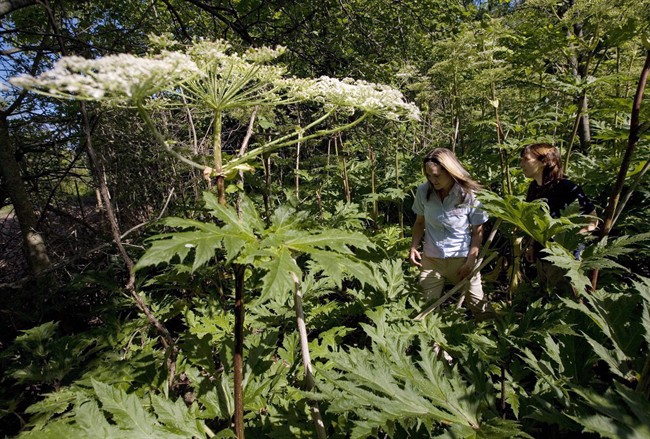Scott McLeod lives in Thamesford. His house backs onto a brush with a river running through it. Last year, after being out back he noticed a blister on the back of his hand.

“It didn’t go away for three or four days. I didn’t know what it was. When I showed it to a lady at work right away she said giant hogweed.”
A year later, the blister is back.
“This year, once the sun was strong enough I guess, the blister came back. This giant hogweed if you get whatever it is on you, the sap or something, it’s light sensitive and these blisters can keep recurring.”
Giant hogweed plants can cause third-degree burns and even permanent blindness. The plant is spreading.
Giant hogweed is cutting a wider swath in B.C. and Ontario, and the Nature Conservancy of Canada is urging people across the country to document sightings of the towering green plant with large umbels of white flowers.
“It’s like poison ivy, but on a whole other level. Where it separates itself from something like poison ivy or stinging nettle is that the blisters will be more severe, you can see heavy, heavy thick purple blotching on the skin and really heavy rashes that can be widespread,” said Brandon Williamson Land Management Technician with the Upper Thames River Conservation Authority (UTRCA).
Giant hogweed is photo-toxic.
“If you walk through it or you get it on your skin and then you go out into the sun it will heighten that sensitivity and make the issues worse. The rash or the blistering, it’ll actually make it worse,” said Williamson.
According to the UTRCA’s website, symptoms occur within 48 hours and consist of painful, burning blisters that can cause severe irritation, dermatitis, and develop into purplish or blackened scars. Depending on individual sensitivity, effects can last for months and skin can remain sensitive to UV light for years. Eye contact with the sap has been reported to cause temporary or permanent blindness.
In London, Williamson says the invasive species is stable. There are a few areas that keep popping up, but nothing noteworthy.
“Outside of the city, in the Thames river in both the north and south branches there’s definitely and increase in population for giant hogweed. It’s on its way here it’s just a matter of how long it will take to get here and populate this area,” said Williamson.
Giant hogweed is on the move, and its favourite mode of transportation is spreading its seeds.
“Each plant produces 50,000-150,000 seeds, and seeds every 2-3 years. Once a plant flowers and seeds, it dies, but those seeds are viable in the soil for up to 15 years. During spring floods seeds are transported down stream, they germinate, and the cycle continues,” said Williamson.
He says right now they’re seeing giant hogweed pop up in a lot of rural areas along the Thames river and other creeks. Eventually the seeds will drain down the Thames and into London.
“It could be 2 years it could be 10 years, it’s kind of just a wait and see, for London anyway,” said Williamson.
He adds, if giant hogweed is on private property it’s the owners’ responsibility to contact a professional and have it removed. However, if it is on an environmentally significant area, you can call the UTRCA, and they’ll have it taken care of.
Williamson says there are a few plants that look similar to giant hogweed, such as cowparsnip and angelica, so it’s important to know what you’re looking for. You can head to the Ontario Invasive Plant Council’s website or to thamesriver.on.ca for comparative pictures and better explanation of giant hogweed in the London area.
The Nature Conservancy of Canada is asking people to document sightings of the invasive plant through apps such as iNaturalist, which helps scientists understand how the plants are spreading and identifies areas where they need to be eradicated.
With files from the Canadian Press







Comments